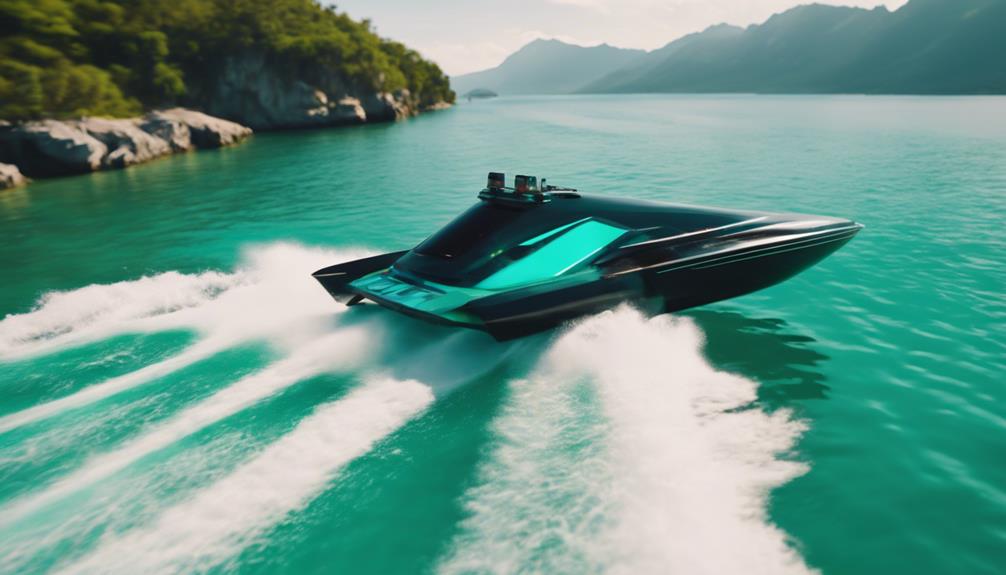A jet boat is a unique watercraft that uses jet propulsion to move swiftly across rivers and shallow waters. It ejects water from the stern, which allows for exciting speeds of up to 50 knots. You can navigate in as little as 3 inches of water, making it great for exploring tricky spots. Its enclosed impeller system enhances safety by reducing injury risks. Plus, with fewer moving parts, maintenance is easier and costs are lower. The impressive handling and maneuverability make jet boats popular for adventure tourism and racing. Curious about their features and history? There's more to discover!
Key Takeaways
- Jet boats use jet propulsion, ejecting water from the stern for forward movement and enhanced maneuverability.
- They can navigate shallow waters as low as 7.5 cm (3 inches), minimizing hull damage risks.
- With high-speed capabilities reaching up to 50 knots, they offer thrilling experiences for users.
- Jet boats feature an enclosed impeller system, increasing safety by reducing injury risks from external rotating parts.
Definition of Jet Boat
A jet boat is a type of vessel that uses a powerful jet of water ejected from the stern to propel itself forward. This innovative design relies on jet propulsion rather than traditional propellers, which gives you several advantages.
Unlike boats with exposed propellers, jet boats utilize an enclosed impeller system. This not only enhances safety by reducing the risk of injuries but also improves performance, allowing for faster acceleration and better handling.
One of the standout features of jet boats is their ability to navigate shallow waters. You can operate in depths as low as 7.5 cm (3 inches) without damaging the hull, making them ideal for exploring rivers and lakes where other boats can't go.
Their high-speed capabilities often allow you to reach speeds of up to 50 knots, providing an exhilarating experience. Additionally, the design of jet boats eliminates protruding components below the hull. This means you can glide through narrow passages with ease, minimizing the risk of hull strikes.
Historical Background
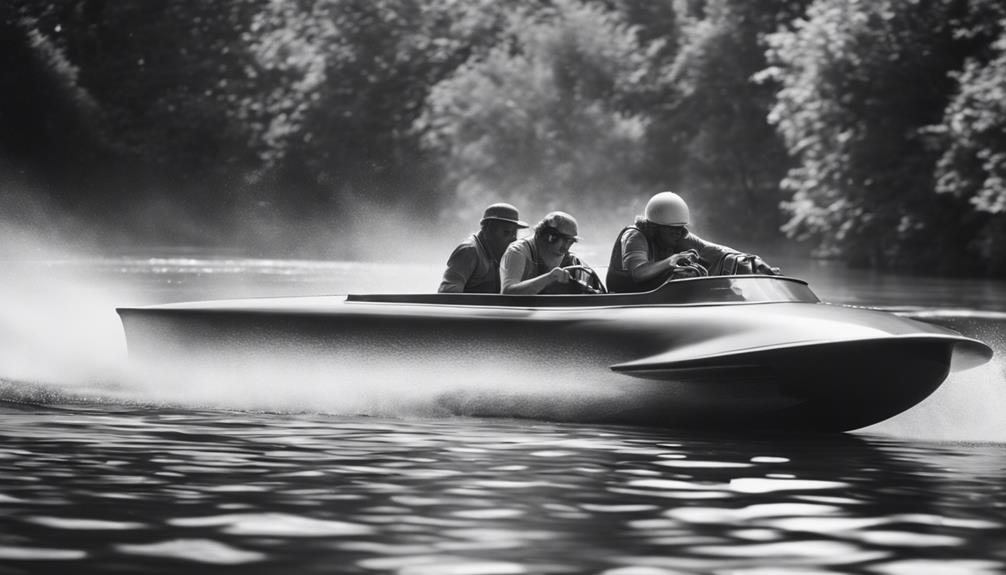
The evolution of jet boats traces back to the mid-1950s when Sir William Hamilton sought to enhance navigation in New Zealand's shallow rivers. His innovative approach led to the development of the first jet unit, which utilized a Ford engine and a bevel gear-operated pump. This significant advancement laid the groundwork for modern jet propulsion designs in boating.
Early jet boats, while inspired by American designs, were customized to perform better in shallow waters. This adaptation marked a pivotal moment in marine technology, allowing these vessels to navigate areas where traditional propeller-driven boats struggled. By the 1990s, the popularity of jet boats surged, largely due to advancements in engine technology and the growing interest in recreational boating.
Key milestones in the historical background of jet boats include:
- Sir William Hamilton's pioneering designs in the 1950s.
- The introduction of the first jet unit with a Ford engine.
- Adaptations from American designs for enhanced shallow water performance.
These developments showcase the ongoing innovations in marine engineering and jet propulsion systems that continue to shape the industry today.
Mechanics of Jet Boats

Jet boats rely on a water jet propulsion system to generate thrust, drawing water in and expelling it through a nozzle.
You'll find that steering is achieved by directing this jet stream, which makes these boats incredibly agile.
With fewer moving parts than traditional propeller systems, jet boats also require less maintenance, enhancing their overall efficiency.
Propulsion System Explained
Water jet propulsion systems power jet boats by drawing in water from beneath the hull and expelling it at high velocity through a nozzle at the stern, creating thrust and exceptional maneuverability. This propulsion system isn't just efficient but also enhances safety by enclosing the impeller within a housing, preventing direct contact with spinning components.
Here are some key features of jet boat propulsion systems:
- Shallow Water Operation: Jet boats can navigate in as little as 7.5 cm (3 inches) of water, making them perfect for tight spots.
- Single-Stage Units: Most modern jet boats utilize single-stage jet units for streamlined performance.
- Multi-Stage Designs: Older models may feature multi-stage designs to optimize power in different conditions.
Understanding the intricacies of the propulsion system helps you appreciate how jet boats excel in performance and versatility, enabling thrilling adventures on the water.
Steering and Maneuverability
Effective steering in jet boats relies on directional thrust generated by adjusting the nozzle, allowing you to make sharp turns and execute rapid stops with ease. Unlike traditional propeller-driven boats, jet boats need the engine to be running for steering, so you'll always have that engine humming while you navigate.
The unique propulsion system gives you impressive control, even in shallow waters as shallow as 7.5 cm (3 inches). This capability allows you to explore areas where other boats can't go, enhancing your overall experience. When you need to maneuver in tight spaces, you can utilize reverse thrust by lowering a deflector into the jet stream, redirecting thrust forces to move backward smoothly.
Additionally, the hull design of jet boats plays an essential role in their high-speed cornering control and stability. This makes them not only fun for recreational use but also effective in tactical operations.
With a jet boat, you can confidently navigate various water conditions, knowing that your steering and maneuverability are optimized for performance. Whether you're making quick turns or stopping suddenly, jet boats are engineered to meet your needs on the water.
Performance Characteristics

When you think about jet boats, their unique propulsion mechanism stands out, enabling impressive speed and efficiency.
You'll notice how their design allows for incredible maneuverability and stability, making them perfect for steering through tight spaces.
Let's explore how these features come together to enhance your overall boating experience.
Propulsion Mechanism Explained
Jet boats rely on a powerful water jet propulsion system that draws in water from beneath the hull, accelerates it through impellers, and expels it at high speed through a stern nozzle, delivering impressive thrust and maneuverability.
This innovative jet propulsion technology allows you to enjoy thrilling speeds of up to 50 knots, making jet boats ideal for both recreational and tactical uses.
Here are some key performance characteristics of jet propulsion systems in jet boats:
- Shallow Water Operation: Jet boats can navigate in as little as 7.5 cm (3 inches) of water, reducing the risk of hull damage.
- Responsive Steering: You can steer by adjusting the direction of the jet stream, which enhances control.
- Quick Stops: The ability to generate reverse thrust using deflectors allows for effective low-speed maneuvers.
With these features, jet propulsion in jet boats guarantees you'll have an exhilarating experience while maintaining safety and control on various water conditions.
Maneuverability and Stability
The unique design of jet boats not only enhances their propulsion capabilities but also greatly improves their maneuverability and stability on the water. With a shallow draft, these boats can operate in just 7.5 cm (3 inches) of water, making them perfect for traversing tight spaces. The lack of protruding components below the hull reduces drag, allowing for quick acceleration and efficient navigation in shallow waters.
Steering in a jet boat is achieved through the directional control of the water jet, which enables you to make rapid turns and crash stops without needing large turning radii. You'll appreciate how jet boats can perform high-speed cornering while still maintaining stability, thanks to their flat bottom hull design and water jet propulsion system.
Additionally, the implementation of reverse thrust by redirecting the jet stream enhances low-speed maneuverability, giving you better control even in challenging conditions. Whether you're dodging obstacles or making sharp turns, jet boats excel in delivering a responsive and stable ride, making them an excellent choice for those who crave adventure on the water.
Advantages of Jet Boats
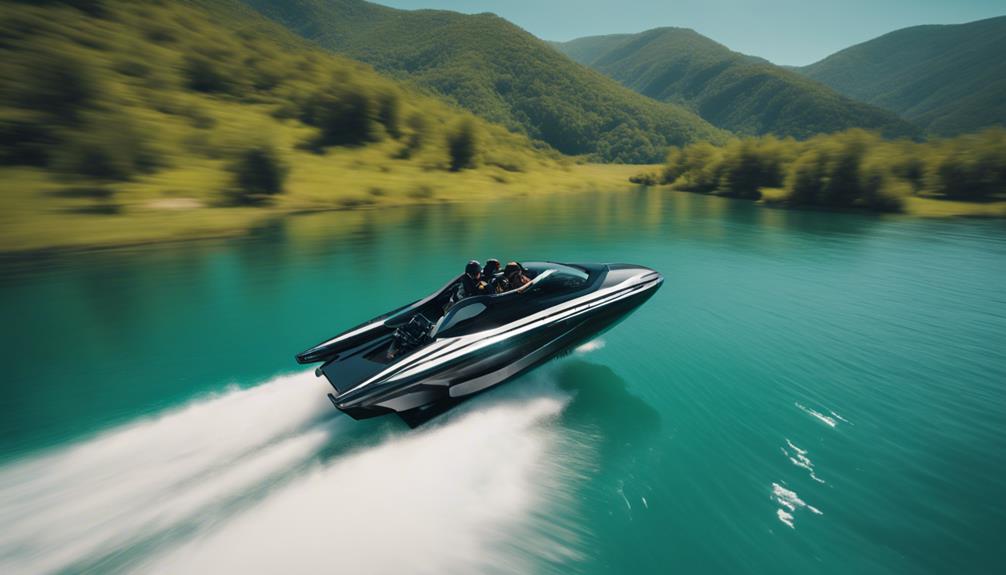
One major advantage of jet boats is their ability to navigate in extremely shallow waters, with a minimum depth of just 7.5 cm (3 inches), opening up areas that traditional boats simply can't access. This capability allows you to explore unique waterways and hidden gems that others can't reach.
Additionally, jet boats feature a propulsion system that expels water from the stern, eliminating external components like propellers. This design reduces the risk of damage to underwater obstacles and marine life, making jet boats a safer choice for nature enthusiasts.
Here's why you'll love jet boats:
- Exceptional Maneuverability: They can execute sharp turns and rapid stops, enhancing safety in tight spaces.
- High-Speed Thrills: With speeds up to 50 knots, they offer exhilarating experiences for adventure seekers.
- Low Maintenance: Fewer moving parts mean lower ownership costs and less time spent on upkeep.
With these advantages, jet boats provide a unique blend of excitement and practicality, making them a fantastic option for both leisure and exploration.
Limitations of Jet Boats
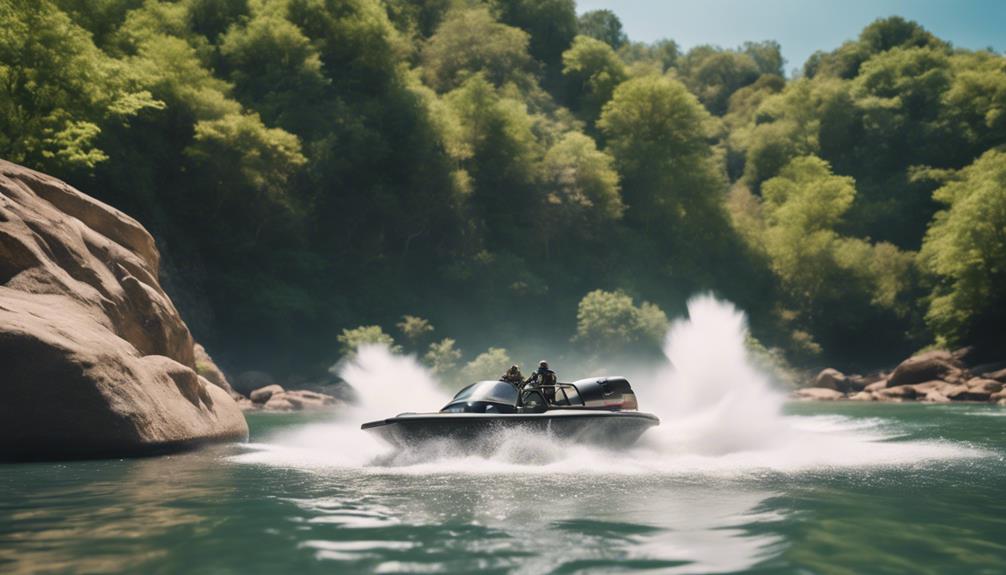
While jet boats offer unique advantages, they do have notable limitations.
You might find their top speed lacking compared to propeller-driven boats, which can be a drawback if you're chasing high performance.
Additionally, expect a rougher ride in choppy waters and some steering challenges at low speeds that could affect your maneuverability.
Speed Limitations Compared to Propellers
Jet boats often struggle with speed compared to propeller-driven boats due to their smaller engines and the inherent limitations of jet propulsion systems at high speeds. While they perform well at lower speeds, these speed limitations become pronounced as you push the throttle. You'll find that jet boats can't quite match the top speeds of larger, more powerful propeller-driven vessels.
Here are a few key points to take into account:
- Jet boats usually have smaller engines, which caps their maximum speed.
- Jet propulsion systems are less efficient at high speeds, limiting performance.
- Their lightweight design may result in instability, affecting speed in rough conditions.
Understanding these speed limitations is vital when deciding between a jet boat and a propeller-driven alternative.
If you're looking for thrilling high-speed adventures, a propeller boat might be your best bet. However, if you prioritize shallow water navigation and nimble handling at lower speeds, a jet boat could be the right choice for you.
Rough Ride in Choppy Waters
Steering through choppy waters in a jet boat can be quite a bumpy experience, often leading to discomfort for passengers due to its lightweight design.
Unlike heavier boats, jet boats lack a traditional keel, which limits their ability to cut through waves effectively. This results in a ride that's bouncier and less stable in rough conditions.
While advancements have enhanced slow-speed handling, jet boats still rely heavily on directional thrust. This makes them more susceptible to instability when the waters get turbulent.
You might find that maneuvering choppy seas requires more skill and attention, as jet boats can be less forgiving than their propeller-driven counterparts.
At high speeds, jet boats may struggle to maintain comfort, especially in rough seas. The impeller-driven propulsion system is optimized for low-speed maneuverability, but when the waters get rough, you may feel every wave.
Operators must be attentive and adjust their steering to keep control. If you're considering a jet boat for your adventures, it's crucial to be aware of these limitations and prepare for a potentially rough ride in choppy waters.
Steering Challenges at Low Speeds
Maneuvering a jet boat at low speeds presents unique challenges due to its reliance on directional thrust for steering. Unlike traditional boats that use rudders, jet boats depend on the flow of water through the jet unit to guide their movements. When you're operating at slow speeds, the reduced water flow can greatly diminish steering responsiveness and control.
Here are some challenges you might face:
- Difficulty executing precise turns
- Reduced ability to stop quickly
- Increased need for careful handling
You'll notice that the maneuverability of your jet boat is best at higher speeds, making it a thrill to navigate swiftly. However, as you slow down, that performance drops, necessitating extra caution and skill.
While technological advancements have made improvements in slow-speed handling, the fundamental issues remain. So, when you're out on the water, keep in mind that maintaining control at lower speeds will require your full attention and a bit more throttle to get the jet unit working effectively.
Applications and Use Cases

These versatile boats are perfect for a variety of applications, from recreational river tours to critical military and rescue operations. If you're looking for an exhilarating way to explore scenic waterways, a jet boat offers the thrill you crave.
With their ability to maneuver in shallow waters, they make a great choice for back-country adventures, hunting trips, and traversing narrow passages where traditional boats struggle.
Jet boats have also found a significant role in military and rescue operations. Their high maneuverability allows them to operate in challenging environments, making them essential for quick response scenarios. When time is of the essence, these boats can transport personnel and equipment to remote areas that other vessels can't access.
Adventure tourism has surged with the rise of jet boat usage, offering tailored experiences for thrill-seekers in rugged wilderness settings like Hells Canyon. Whether you're fishing, farming, or exploring new territories, a jet boat provides the agility and speed needed to tackle diverse tasks.
With such a wide range of applications, it's no wonder jet boats are becoming a popular choice for both leisure and essential services.
Safety Features
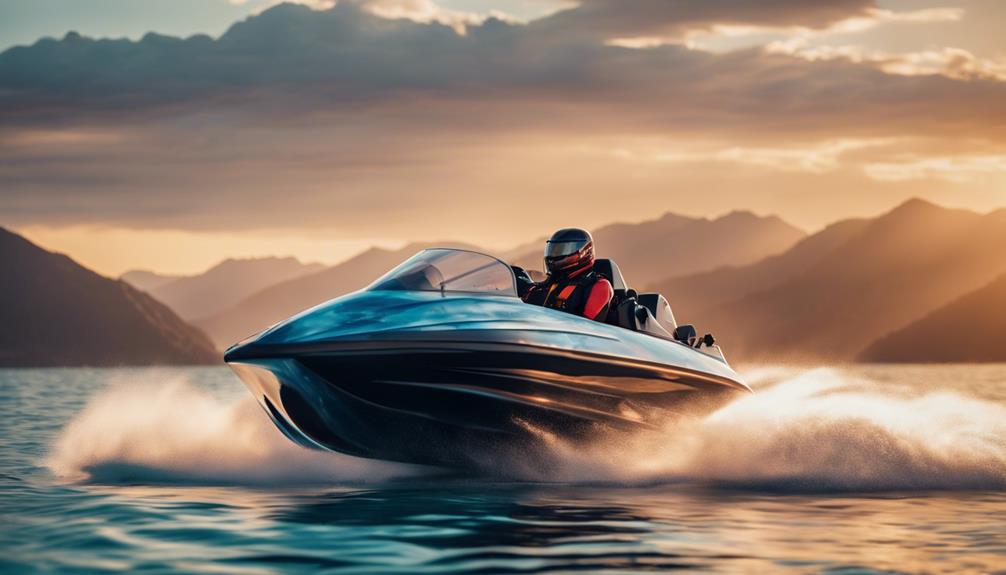
When exploring the thrilling applications of jet boats, it's important to contemplate their safety features, which considerably enhance your experience on the water. Jet boats are designed with several characteristics that prioritize your safety and that of your passengers.
- Enclosed impeller system: This minimizes the risk of swimmer injuries from spinning blades, making your outings safer.
- No external rotating parts: This reduces the likelihood of entanglement or injury to passengers and marine life, distinguishing jet boats from traditional propeller-driven vessels.
- Shallow water operation: Jet boats can navigate in very shallow waters—typically as shallow as 7.5 cm (3 inches)—which decreases the risk of hull strikes, allowing for safer exploration in tighter areas.
These safety features combine to provide a secure and enjoyable experience on the water, allowing you to focus on the excitement of your jet boat adventures without unnecessary worry.
Racing and Competitions
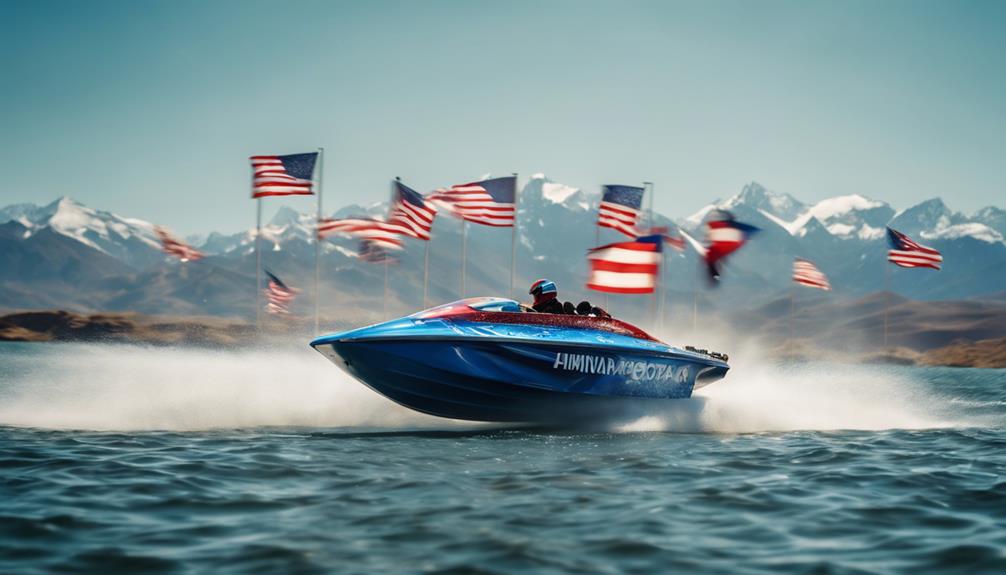
Jet boat racing captivates thrill-seekers, featuring high-speed competitions on rivers and specially designed sprint tracks across the globe. Whether you're in Mexico, Canada, the USA, or New Zealand, the adrenaline rush of watching these powerful machines navigate through challenging courses is unmatched. The World Champion Jet Boat Marathon stands out as one of the most prestigious events, showcasing various jet boat designs and their capabilities.
You'll notice that jet boat racing includes both recreational and professional categories, attracting enthusiasts from diverse backgrounds. The thrill lies in the jet boats' ability to execute rapid stops and sharp turns, which keeps both racers and spectators on the edge of their seats. Every twist and turn highlights the skill of the drivers and the advanced technology behind the boats.
As innovations in jet propulsion continue to evolve, the sport draws even more interest. With new designs and techniques emerging, you can expect the excitement of jet boat racing to grow. Whether you're a competitor or a spectator, the blend of speed, agility, and engineering makes jet boat racing an exhilarating experience you won't want to miss.
Cultural Impact and Significance

Racing isn't the only way jet boats influence our lives; their cultural impact and significance resonate through media, tourism, and the adventurous spirit they inspire.
You'll often see jet boats showcased in films and literature, symbolizing freedom and exploration as they glide through scenic waterways. This representation not only captures the thrill of adventure but also highlights a shift in boating technology, moving from traditional propeller-driven vessels to innovative water jet propulsion systems.
Jet boats play a crucial role in enhancing tourism, offering unique experiences that draw adventure seekers to picturesque locations. Here are a few ways they leave their mark:
- Adventure Tourism: Jet boats provide thrilling river tours and water sports experiences.
- Media Representation: They frequently appear in outdoor and adventure films, showcasing their excitement.
- Cultural Symbolism: Jet boats embody freedom and the spirit of exploration in various narratives.
In essence, jet boats are more than just vessels; they're a cultural phenomenon that reflects our desire for adventure.
Frequently Asked Questions
What Is Considered a Jet Boat?
A jet boat's considered a vessel that uses a water jet for propulsion instead of a propeller. You'll find it operates well in shallow waters and can reach high speeds, perfect for various activities.
Why Is It Called a Jet Boat?
When you hear “jet boat,” think of thrilling river adventures. It's called a jet boat because it uses water jet propulsion, allowing for high speeds and shallow navigation, setting it apart from traditional propeller-driven vessels.
What Is the Theory of Jet Boats?
The theory of jet boats revolves around Newton's third law: when water's expelled at high speed, it pushes the boat forward. You'll find their shallow draft lets you navigate tight spaces effortlessly.
What Is the Difference Between a Speed Boat and a Jet Boat?
The main difference between a speed boat and a jet boat lies in propulsion. Speed boats use propellers for movement, while jet boats rely on water jets, offering better maneuverability and performance in shallow waters.
Conclusion
In the world of watercraft, jet boats are like sleek arrows slicing through the waves, offering an exhilarating ride that's hard to forget.
You've explored their mechanics, advantages, and cultural significance, uncovering a vessel that's not just about speed but adventure and freedom.
So, whether you're traversing serene lakes or racing down rivers, jet boats invite you to embrace the thrill, turning every journey into a splash of excitement and a dance with the water's spirit.





